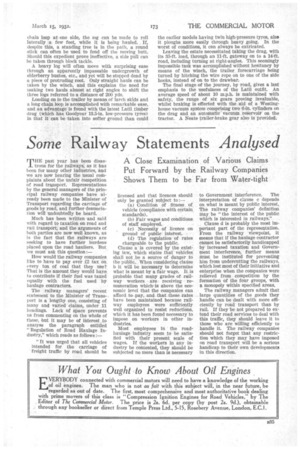Some Railway Statements Analysed A Close Examination of Various Claims
Page 53

If you've noticed an error in this article please click here to report it so we can fix it.
Put Forward by the Railway Companies Shows Them to be Far from Water-tight T"past year has been disastrous for the railways, as it has been for many other industries, and we are now hearing the usual coinplaints about the unfair competition of road transport. Representations by the general managers of the principal railway companies have already been made to the Minister of Transport regarding the carriage of goods by road, and further denunciation will undoubtedly be heard.
Much has been written and said with regard to taxation on road and rail transport and the arguments of both parties are now well known, as is the fact that the railways are seeking to have further burdens placed upon the road hauliers. But we must ask this question:—
How would the railway companies_ like to have to pay over 12 tax on. every ton of coal that they use?, That is the amount they would have 10 contribute if their fuel was taxed equally with the fuel used by haulage contractors.
The railway managers' recent statement to the Minister of Trans-. port is a lengthy one, consisting of many and varied claims, under .11 headings. Lack Of mace prevents Bs from commenting on the whole of these, but it may be of interest to analyse the paragraph entitled "Regulation of Road Haulage Industry," which reads as follows :—
"It was urged that all vehicles intended for the carriage of freight traffic by road should be licensed and that licences should only be granted subject to :-.-
(a) Condition a fitness of vehicle (compliance with certain
standards). .
(b) Fair wages and conditions of staff employed.
(c) Necessity of licence on ground of public intei•est.
(d) The regulation of rates chargeable to the public.
Clause a is covered by the existing law, which states that vehicles shall not be a source of danger to the public. When considering clause b it will be necessary to determine what is meant by a fair wage. It is probable that many grades of railway workers are receiving remuneration which is above the economic level that the companies can afford to -pay, and that these -rates have been maintained because railway employees were sufficiently well organized to resist reductions, which it has been found necessary to impose on -workers in other industries.
Most employees in the roadhaulage Industry seem to be satisfied with their present scale of wages. If the workers in any industry be contented, they should be subjected no more than is necessary to -Government interference. The interpretation of clause c depends on what is meant by public interest, The railway companies definition may be "the interest of the public which is interested in railways."
Clause d is probably the most important part of the representation. From the railway viewpoint, it means that if the haulage contractor cannot be satisfactorily handicapped by increased taxation and Government interference, further means Must be instituted for preventing him from undercutting the railways, which lost most of their initiative and enterprise when the companies were relieved from competition by the formation of the four groups, with monopoly within specified areas.
The railway managers admit that large quantities of the goods they handle can be dealt with more efficiently by road transport than by rail. If they be not prepared to extend their road services to deal with this traffic, they should leave it to those who are willing efficiently to handle it. The railway companies should not forget that any restriction which they may have imposed on road transport will be a serious handicap to their own developments in this direction.




































































































